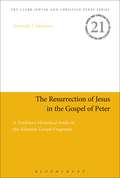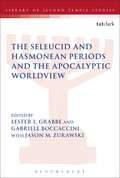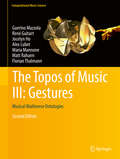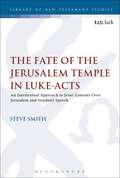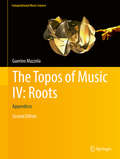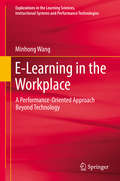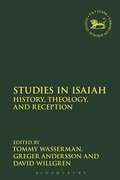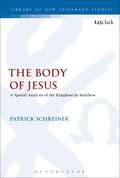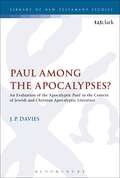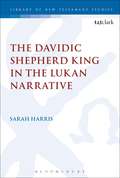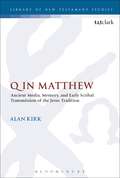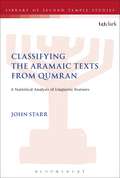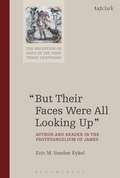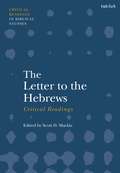- Table View
- List View
The Resurrection of Jesus in the Gospel of Peter: A Tradition-Historical Study of the Akhmîm Gospel Fragment (Jewish and Christian Texts #21)
by Jeremiah J. JohnstonAll four canonical gospels identify the resurrection of Jesus, yet none detail the exact moment of its happening. The absence of this narrative detail was hotly contested in the second century, when critics derided a resurrection account without credible witness. Thus, the discovery of the Akhmim fragment at the end of the 19th century, which purports to provide exactly that detail, is a huge and surprisingly under-utilised addition to Biblical scholarship of the Apocryphal gospels. Johnston examines both the impact of this discovery on the scholarship at the time, and argues for the dating of the fragment to the second century AD. He identifies shared characteristics with other documents from this period, including a rise in anti-semitic feeling, and developments in concepts of the afterlife, and makes a claim for this fragment being the text that aided the development of these movements.The Second Century was the key time in which the non-canonical Biblical texts were established. It was also the era in which theologies which would become 'orthodox' in the third century were penned and defined. The significance, then, of dating the Akhmim fragment to the second century AD is huge. This work will be of great use to scholars of Second Temple Judaism, and those with an interest in the creation of the ideas that surround scholarship of the Bible.
The Seleucid and Hasmonean Periods and the Apocalyptic Worldview (The Library of Second Temple Studies #88)
by Lester L. Grabbe Gabriele Boccaccini Jason M. ZurawskiThis tightly focused collection of essays, from an invited seminar of international specialists, centres on the question of the apocalyptic worldview around the time of the Maccabean revolt. What was the nature of apocalyptic at this time? Did the Maccabees themselves have a distinct apocalyptic worldview? These questions lead to other, more specific queries: who of the various groups held such a view? Certain of the essays analyse the characteristics of the apocalypses and related literature in this period, and whether the apocalyptic worldview itself gave rise to historical events or, at least, influenced them.The collection begins with two introductory essays. Both the main and short papers have individual responses, and two considered responses by well-known experts address the entire collection. The volume finishes with a concluding chapter by the lead editor that gives a perspective on the main themes and conclusions arising from the papers and discussion.
New Vistas on Early Judaism and Christianity: From Enoch to Montreal and Back (Jewish and Christian Texts)
by Lorenzo DiTommaso Gerbern S. OegemaThe study of early Judaism and early Christianity has been revolutionised by new evidence from a host of sources: the Dead Sea Scrolls, the Pseudepigrapha, the New Testament Apocrypha, the Nag Hammadi writings and related texts, and new papyrus and amulet discoveries. Now scholars have entered the “next generation” of scholarship, where these bodies of evidence are appreciated in conversation with each other and within the contexts of the wider Jewish, Christian, and Greco-Roman cultures from the fourth century BCE to the fourth century CE.This volume features chapters from leading scholars who approach the study of early Judaism and early Christianity from this synthetic approach. The chapters engage in an inter-generational and international dialogue among the past, present and future generations of scholars, and also among European, North-American, African and South-American scholars and their various methodologies and approaches –- linguistic, historical or comparative. Among the chapters are contributions by Professors James Charlesworth (Princeton), André Gagné (Concordia) and Loren Stuckenbruck (Munich), as well as papers from researchers from North America, Europe, South America and Africa.
The Topos of Music III: Musical Multiverse Ontologies (Computational Music Science)
by Guerino Mazzola René Guitart Jocelyn Ho Alex Lubet Maria Mannone Matt Rahaim Florian ThalmannThis is the third volume of the second edition of the now classic book “The Topos of Music”. The authors present gesture theory, including a gesture philosophy for music, the mathematics of gestures, concept architectures and software for musical gesture theory, the multiverse perspective which reveals the relationship between gesture theory and the string theory in theoretical physics, and applications of gesture theory to a number of musical themes, including counterpoint, modulation theory, free jazz, Hindustani music, and vocal gestures.
New Testament Texts on Greek Amulets from Late Antiquity (The Library of New Testament Studies #554)
by Brice C. JonesBrice C. Jones presents a comprehensive analysis of Greek amulets from late antique Egypt which contain New Testament citations. He evaluates the words they contain in terms of their text-critical value. The use of New Testament texts on amulets was common in late antiquity. These citations were extracted from their larger Biblical contexts and used for ritual purposes that have traditionally been understood in terms of the ambiguous category of 'magic'. Often, these citations were used to invoke the divine for some favour, healing or protection. For various reasons, however, these citations have not played a significant role in the study of the text of the Greek New Testament.As such, this is the first systematic treatment of Greek New Testament citations on amulets from late antique Egypt. Jones' work has real implications for how amulets and other such witnesses from this era should be treated in the future of the discipline of New Testament textual criticism.
Institutions of the Emerging Church (The Library of New Testament Studies #305)
by Sven-Olav Back Erkki KoskenniemiThe contributors to this volume address the key institutions of the first and second Church, considering the development of rituals and sacraments, and the development of Church leadership, and of the Church itself. The first part of the book looks at the offices of the Church - the Apostolate and the development of other religious authorities - as well as the notion of Apostolic Tradition. The second part looks at the sacraments, with in-depth consideration of the Eucharist, and of Baptismal texts from the early Church. The essays are of interest to scholars researching the development of the early Church and of Church rituals and practices.
The Fate of the Jerusalem Temple in Luke-Acts: An Intertextual Approach to Jesus' Laments Over Jerusalem and Stephen's Speech (The Library of New Testament Studies #553)
by Steve SmithWhat was Luke's attitude to the Jerusalem temple? Steve Smith examines the key texts which concern the destruction of the Jerusalem temple in Luke-Acts. Smith proposes that Acts 7 is a fuller discussion of the material contained in the Gospel sayings on this subject, which themselves make frequent allusion to the Old Testament and the interpretation of which thus requires an understanding of Luke's use of the Old Testament. Accordingly, in this work, Steve Smith makes a thorough review of Luke's use of the Old Testament, and proposes that relevance theory is a capable hermeneutical tool to permit the reconstruction of how Luke's readers would have understood references to the Old Testament. Using this approach, the key texts from Luke-Acts are examined sequentially, and Luke's apparent criticism of the temple is examined in a new light.
The Topos of Music IV: Appendices (Computational Music Science)
by Guerino MazzolaThis is the fourth volume of the second edition of the now classic book “The Topos of Music”. The author presents appendices with background material on sound and auditory physiology; mathematical basics such as sets, relations, transformations, algebraic geometry, and categories; complements in physics, including a discussion on string theory; and tables with chord classes and modulation steps.
War in Chronicles: Temple Faithfulness and Israel's Place in the Land (The Library of Hebrew Bible/Old Testament Studies #627)
by Troy D. CudworthTaking on the established view of Chronicles, which uses retribution theology - the view that the author of Chronicles re-worked the texts in Samuel-Kings to demonstrate that Yahweh rewards the good and punishes the wicked - Troy Cudworth argues that this cause-effect relationship is maintained primarily through the treatment of the themes of war and temple-faithfulness. Cudworth identifies a division of kings into categories, with the immediate exception of David, who belongs in his own category as he pioneered the two most foundational elements of the temple cult. For this reason, he also won many battles to secure Israel's place in the land. The next two groups of kings can be dichotomised in the following way: those who show faithfulness to the temple cult and its practices, and those who neglect it.Based on their attitude to the temple, the Chronicler illustrates how the kings either prosper in the land through military victory or suffer attack. Although many kings begin as faithful in supporting orthodox temple practices, and thus prosper on the battlefield, none of these kings are consistent and persevere in their faithfulness and so their success either stops immediately, or they suffer attack. Conversely, other kings are illustrated who, despite committing some of the worst sins in Israel's history, repent immediately after their swift punishment. Across all of these cases, it is shown how temple faithfulness always ultimately guarantees peace and security for Israel.
The Bible in Political Debate: What Does it Really Say?
by Frances Flannery Rodney A. WerlinePoliticians and pundits regularly invoke the Bible in social and political debates on a host of controversial social and political issues, including: abortion, stem-cell research, gay marriage, the death penalty, separation of church and state, family values, climate change, income distribution, teaching evolution in schools, taxation, school prayer, aid for the poor, and immigration. But is the Bible often used out of context in these major debates?This book includes essays by fourteen biblical scholars who examine the use of the Bible in political debates, uncovering the original historical contexts and meanings of the biblical verses that are commonly cited. The contributors take a non-confessional approach, rooted in non-partisan scholarship, to show how specific texts have at times been distorted in order to support particular views. At the same time, they show how the Bible can sometimes make for unsettling reading in the modern day. The key questions remain: What does the Bible really say? Should the Bible be used to form public policy?
E-Learning in the Workplace: A Performance-Oriented Approach Beyond Technology (Explorations in the Learning Sciences, Instructional Systems and Performance Technologies)
by Minhong WangThis book analyzes the nature and requirements of workplace e-learning based on relevant theories such as adult learning, community of practice, organizational learning, and the systems thinking. By integrating considerations on organization, pedagogy and technology, a performance-oriented e-learning framework is then presented, where performance measurement is used to: 1) clarify and link organizational goals and individual learning needs, 2) direct learning towards work performance; and 3) support social communication and knowledge sharing and management in the workplace. E-learning and related emerging technologies have been increasingly used by organizations to enhance the skills and performance of knowledge workers. However, most of the efforts tend to focus on the technology, ignoring the organizational context and relevant pedagogies of workplace learning. Many e-learning projects in the workplace settings fail to connect learning with work performance and align organizational goals and individual needs in a systemic way. Moreover, there is insufficient effort on externalizing and transferring tacit knowledge embedded in practices and expertise, based on which to maintain and expand knowledge assets for sustainable development. The book presents a systemic theoretical framework, design principles, and implementation methods, together with a case study to demonstrate the use and effectiveness of the performance-oriented approach to workplace e-learning, in which organizational, social and individual perspectives are integrated in a systemic way. The performance-oriented approach to workplace e-learning enables self-regulated and socially constructed learning activities to be clearly motivated and driven towards the goal of performance improvement, and makes learning at the organizational, social and individual levels integrated in a systemic way. The effects of individual and social learning support and organizational learning environment on employees’ motivation to use performance-oriented e-learning are also investigated.
Phinehas, the Sons of Zadok, and Melchizedek: Priestly Covenant in Late Second Temple Texts (The Library of Second Temple Studies #90)
by Dongshin Don ChangDongshin Don Chang examines 1 and 2 Maccabees, the Dead Sea Scrolls, and Hebrews to see how the combined concepts of covenant and priesthood are defined and interlinked within various biblical and extra-biblical traditions. The three studies show the interesting and varying dynamics of the use of combined concepts of covenant and priesthood. The articulations of the two entities are shown to reflect, in part, the concern of the Second Temple Jewish authors; how significant the priestly institutions and priesthood were, not only in cultic matters, but also in relation to political and authoritative concerns.Chang's analysis makes clear that some of the Second Temple compositions have pursued ideas of the legitimacy of priestly identities by juxtaposing the concepts of covenant and priesthood from various traditions. Interpretation and representation of certain traditions becomes a way in which some Second Temple Jews, and some members of the early Jewish Christian communities, developed their priestly covenantal identities. It is with an understanding of this, Chang argues, that we can better understand these Second Temple texts.
Representations of the Afterlife in Luke-Acts (The Library of New Testament Studies)
by Alexey SomovQuestions regarding the afterlife are many, and the Gospel of Luke and the book of Acts pay a great deal of attention to them: why does Luke speak about several different forms of the afterlife? Why is resurrection described as a person's transformation into an angelic being? How many abodes are appointed for the righteous and the wicked after death? Alexey Somov addresses these queries in relation to the apparent confusion and variety found in the text, and in respect of the interrelatedness of these issues, and their connection with other eschatological issues in Luke-Acts, and in relation to the wider cultural context of the Mediterranean world to which Luke belonged.Every culture expresses its beliefs by means of special metaphors that allow it to comprehend supernatural realities in terms of everyday experience. Belief in the afterlife was part of this metaphorical system which Luke shared with the ancient eastern Mediterranean culture. Somov takes his analysis one step further by applying Cognitive Metaphor Theory to selected metaphorical aspects of the afterlife. While the inconsistencies and incoherence of the combined metaphors may seem jarring to a contemporary Western reader, Somov's reading enables a recognition of the specific religious metaphors used, which for Luke would have been current and widely accepted.
Early Church Understandings of Jesus as the Female Divine: The Scandal of the Scandal of Particularity (The Library of New Testament Studies #557)
by Sally DouglasCentral to debates about Jesus is the issue of whether he uniquely embodies the divine. While this discussion continues unabated, both those who affirm and those who dismiss, Jesus' divinity regularly eclipse the reality that in many of the earliest strands of the Christian tradition when Jesus' divinity is proclaimed, Jesus is imaged as the female divine. Sally Douglas investigates these early texts, excavates the motivations for imaging Jesus as Woman Wisdom and the complex reasons that this began to be suppressed in the 2nd and 3rd centuries. The work concludes with an exploration of the powerful implications of engaging with the ancient proclamation of Jesus-Woman Wisdom in contemporary context.
Studies in Isaiah: History, Theology, and Reception (The Library of Hebrew Bible/Old Testament Studies #654)
by Tommy Wasserman Greger Andersson David WillgrenThe Book of Isaiah is considered one of the greatest prophetic works in the Hebrew Bible/Old Testament. The complex history of the book's composition, over several time periods, can often perplex and enthrall. The editors to this volume encourage readers to engage deeply with the text in order to get a grasp of the traces and signs within it that can be seen to point to the book's process of composition and ongoing reinterpretation over time. The contributions discuss suggested segments of composition and levels of interpretation, both within the book of Isaiah and its history of reception. The book is divided into two sections: in the first part certain motifs that have come to Isaiah from a distant past are traced through to their origins. Arguments for a suggested 'Josianic edition' are carefully evaluated, and the relationship between the second part of Isaiah and the Book of Psalms is discussed, as are the motifs of election and the themes of Zion theology and the temple. The second part of the book focuses on the history of reception and looks at Paul's use of the book of Isaiah, and how the book is used, and perhaps misused in a contemporary setting in the growing churches in Africa. With a range of international specialists, including Hugh Williamson, Tommy Wasserman, and Knut Holter, this is an excellent resource for scholars seeking to understand Isaiah in a greater depth.
The Body of Jesus: A Spatial Analysis of the Kingdom in Matthew (The Library of New Testament Studies #555)
by Patrick SchreinerLittle attention is usually given to the space or place of the kingdom. Yet Matthew employs the distinctive phrase "kingdom of heaven†? and also portrays Jesus as Immanuel (God with us). In this volume Patrick Schreiner argues that by expanding one's view of space one can see that Jesus' purpose is to reorder the space of the earth in Matthew as the heavenly king. Jesus pierces the barrier between the two realms in his incarnation, and the spaces of heaven and earth begin to collide in his ministry. Therefore, in Matthew, Jesus does not just promise a temporal or ethereal kingdom, but one that is located, one that has a sense of rootedness. Jesus is granted authority over this space and inspires people to follow him in this construction project. The spatial kingdom begins in his body, and he extends it to his church by promising his presence.
The Bible, Centres and Margins: Dialogues Between Postcolonial African and British Biblical Scholars
by Johanna Stiebert Musa W. DubeThere has rarely been an effort to address the missing dialogue between British and African scholars, including in regard to the role of British missionaries during the introduction ofthe Bible and Christianity to many parts of Africa. To break this silence, Musa W. Dube and Johanna Stiebert collect expressions from both emerging and established biblical scholars in the United Kingdom and (predominantly) southern African states.Divided into three sets of papers, these contributions range from the injustices of colonialism to postcolonial critical readings of texts, suppression and appropriation; each section complete with a responding essay. Questioning how well UK students understand Africancentred and generated approaches of biblical criticism, whether African scholars consider UK-centric criticism valid, and how accurately the western canon represents current UK based scholarship, these essays illustrate the trends and challenges faced in biblical studies in the two centres of study, and discusses how these questions are better answered with dialogue, rather than in isolation.
Paul Among the Apocalypses?: An Evaluation of the ‘Apocalyptic Paul’ in the Context of Jewish and Christian Apocalyptic Literature (The Library of New Testament Studies #562)
by J. P. DaviesA vibrant and growing field of discussion in contemporary New Testament studies is the question of 'apocalyptic' thought in Paul. What is often lacking in this discussion, however, is a close comparison of Paul's would-be apocalyptic theology with the Jewish and Christian apocalyptic literature of his time, and the worldview that literature expresses. This book addresses that challenge. Covering four key theological themes (epistemology, eschatology, cosmology and soteriology), J. P. Davies places Paul 'among the apocalypses' in order to evaluate recent attempts at outlining an 'apocalyptic' approach to his letters. While affirming much of what those approaches have argued, and agreeing that 'apocalyptic' is a crucial category for an understanding of the apostle, Davies also raises some important questions about the dichotomies which lie at the heart of the 'apocalyptic Paul' movement.
The Davidic Shepherd King in the Lukan Narrative (The Library of New Testament Studies #558)
by Sarah HarrisIn Luke-Acts, Jesus can be seen to take on the attributes of the Davidic shepherd king, a representation successfully conveyed through specific narrative devices. The presence of the shepherds in the birth narrative can be understood as an indication of this understanding of Jesus. Sarah Harris analyses the multiple ways scholars have viewed the shepherds as characters in the narrative, and uses this as an example of how the theme of Jesus' shepherd nature is interwoven into the narrative as a whole.From the starting point of Jesus' human life, Harris moves to later events portrayed in Jesus' ministry in which he is seen to enact his message as God's faithful Davidic shepherd, in particular, the parable of the Lost Sheep and the Zacchaeus pericope (19:1-10). Harris uses this latter encounter to underline that Jesus may be hailed as a King by the crowds as he enters Jerusalem, but he is not simply a king. He is God's Davidic Shepherd King, as prophesied in Micah 5 and Ezekiel 34, who brings the gospel of peace and salvation to the earth.
Q in Matthew: Ancient Media, Memory, and Early Scribal Transmission of the Jesus Tradition (The Library of New Testament Studies #564)
by Alan KirkAdvocates of the established hypotheses on the origins of the Synoptic gospels and their interrelationships (the Synoptic Problem), and especially those defending or contesting the existence of the "source" (Q), are increasingly being called upon to justify their position with reference to ancient media practices. Still others go so far as to claim that ancient media realities force a radical rethinking of the whole project of Synoptic source criticism, and they question whether traditional documentary approaches remain valid at all. This debate has been hampered to date by the patchy reception of research on ancient media in Synoptic scholarship. Seeking to rectify this problem, Alan Kirk here mounts a defense, grounded in the practices of memory and manuscript transmission in the Roman world, of the Two Document Hypothesis. He shows how ancient media/memory approaches in fact offer new leverage on classic research problems in scholarship on the Synoptic Gospels, and that they have the potential to break the current impasse in the Synoptic Problem. The results of his analysis open up new insights to the early reception and scribal transmission of the Jesus tradition and cast new light on some long-conflicted questions in Christian origins.
Joel (T&T Clark International Theological Commentary)
by Christopher R. SeitzThe book of Joel is held to be one of the latest prophetic witnesses; it cites other books of the book of the Twelve prophets with a density that distinguishes it from its neighbours. The concept of the "Day of the LORD" which runs throughout the Minor Prophets as a whole reaches its zenith in Joel and its co-mingling of ecological and military metaphors advances Hosea on the former and anticipates later texts on the latter.In this volume within T&T Clark's International Theological Commentary Series Christopher Seitz starts from a foundation of historical-critical methodology to provide an account of Joel's place and purpose within the book of the Twelve prophets as a whole. Seitz examines the theology and background of Joel, and shows how Joel's theological function can provide a major hermeneutical key to the interpretation of the wider collection, and teases out the precise character of that role.
Muted Voices of the New Testament: Readings in the Catholic Epistles and Hebrews (The Library of New Testament Studies)
by Katherine M. Hockey Madison N. Pierce Francis WatsonPauline- and Gospel-centred readings have too long provided the normative understanding of Christian identity. The chapters in this volume features evidence from other, less-frequently studied texts, so as to broaden perspectives on early Christian identity. Each chapter in the collection focuses on one or more of the later New Testament epistles and answers one of the following questions: what did/do these texts uniquely contribute to Christian identity? How does the author frame or shape identity? What are the potential results of the identities constructed in these texts for early Christian communities? What are the influences of these texts on later Christian identity? Together these chapters contribute fresh insights through innovative research, furthering the discussion on the theological and historical importance of these texts within the canon. The distinguished list of contributors includes: Richard Bauckham, David G. Horrell, Francis Watson, and Robert W. Wall.
Classifying the Aramaic Texts from Qumran: A Statistical Analysis of Linguistic Features (The Library of Second Temple Studies)
by John StarrAnalysis of the scroll fragments of the Qumran Aramaic scrolls has been plentiful to date. Their shared characteristics of being written in Aramaic, the common language of the region, not focused on the Qumran Community, and dating from the 3rd century BCE to the 1st century CE have enabled the creation of a shared identity, distinguishing them from other fragments found in the same place at the same time. This classification, however, could yet be too simplistic as here, for the first time, John Starr applies sophisticated statistical analyses to newly available electronic versions of these fragments. In so doing, Starr presents a potential new classification which comprises six different text types which bear distinctive textual features, and thus is able to narrow down the classification both temporally and geographically.Starr's re-visited classification presents fresh insights into the Aramaic texts at Qumran, with important implications for our understanding of the many strands that made up Judaism in the period leading to the writing of the New Testament.
"But Their Faces Were All Looking Up": Author and Reader in the Protevangelium of James (The Reception of Jesus in the First Three Centuries #1)
by Eric M. EykelThis study of the Protevangelium of James explores the interrelationship of authors, readers, texts, and meaning. Its central aim is to better understand how the process of repetition gave rise to the narratives of the early Christian movement, and how that process continued to fuel the creativity and imagination of future generations. Divided into three parts, Vanden Eykel addresses first specific episodes in the life of the Virgin, consisting of Mary's childhood in the Jerusalem temple (PJ 7-9), her spinning thread for the temple veil (PJ 10-12), and Jesus' birth in a cave outside Bethlehem (PJ 17-20). The three episodes present a uniform picture of how the reader's discernment of intertexts can generate new layers of meaning, and that these layers may reveal new aspects of the author's meaning, some of which the author may not have anticipated.
The Letter to the Hebrews: Critical Readings (T&T Clark Critical Readings in Biblical Studies)
by Scott D. MackieThe Letter to the Hebrews is a key text in the New Testament canon. It has recently received a great deal of attention, prompting a resurgence of scholarly works, and a need to re-engage with some of the foundational works of scholarship on the text. The history of research on Hebrews is presented in this volume of critical readings, edited by Scott D. Mackie. The volume is organized thematically, addressing the following sub-areas: theology, Christology and pneumatology; eschatology; authorship and audience; structure and Greco-Roman influences; the relationship with contemporaneous Judaism, and soteriology. Each section is prefaced by an introduction and summary of the particular theme in Hebrews. At the end of each section is an annotated bibliography to point researchers towards further readings in and engagements with these key themes.
